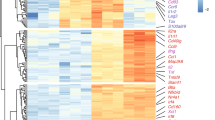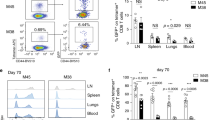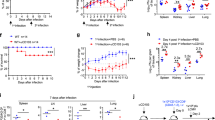Abstract
CD8+ T cells play a central role in antiviral immune responses. Upon infection, naive CD8+ T cells differentiate into effector cells to eliminate virus-infected cells, and some of these effector cells further differentiate into memory cells to provide long-term protection after infection is resolved. Although extensively investigated, the underlying mechanisms of CD8+ T-cell differentiation remain incompletely understood. Themis is a T-cell-specific protein that plays critical roles in T-cell development. Recent studies using Themis T-cell conditional knockout mice also demonstrated that Themis is required to promote mature CD8+ T-cell homeostasis, cytokine responsiveness, and antibacterial responses. In this study, we used LCMV Armstrong infection as a probe to explore the role of Themis in viral infection. We found that preexisting CD8+ T-cell homeostasis defects and cytokine hyporesponsiveness do not impair viral clearance in Themis T-cell conditional knockout mice. Further analyses showed that in the primary immune response, Themis deficiency promoted the differentiation of CD8+ effector cells and increased their TNF and IFNγ production. Moreover, Themis deficiency impaired memory precursor cell (MPEC) differentiation but promoted short-lived effector cell (SLEC) differentiation. Themis deficiency also enhanced effector cytokine production in memory CD8+ T cells while impairing central memory CD8+ T-cell formation. Mechanistically, we found that Themis mediates PD-1 expression and its signaling in effector CD8+ T cells, which explains the elevated cytokine production in these cells when Themis is disrupted.
This is a preview of subscription content, access via your institution
Access options
Subscribe to this journal
Receive 12 digital issues and online access to articles
$119.00 per year
only $9.92 per issue
Buy this article
- Purchase on Springer Link
- Instant access to full article PDF
Prices may be subject to local taxes which are calculated during checkout







Similar content being viewed by others
Data availability
For flow cytometry analysis, antibody-stained cells were run on an LSR-Fortessa X-20 analyzer (BD). All flow cytometry data were analyzed using FlowJo v.10.7.1 software (TreeStar). Statistical analysis was performed using GraphPad Prism 8 (GraphPad Software, San Diego, CA, USA). GraphPad Prism was used for statistical analysis to compare outcomes using a two-tailed unpaired Student’s t test and two-tailed paired Student’s t test for cotransfer experiments; P > 0.05 was considered not significant (ns); *P ≤ 0.05; **P ≤ 0.01; ***P ≤ 0.001 was considered statistically significant. All summarized data are shown in graphs with mean±sd.
References
Zhang N, Bevan MJ. CD8(+) T cells: foot soldiers of the immune system. Immunity. 2011;35:161–8. https://doi.org/10.1016/j.immuni.2011.07.010
Kaech SM, Wherry EJ. Heterogeneity and cell-fate decisions in effector and memory CD8+ T cell differentiation during viral infection. Immunity. 2007;27:393–405. https://doi.org/10.1016/j.immuni.2007.08.007
Zhou X, Ramachandran S, Mann M, Popkin DL. Role of lymphocytic choriomeningitis virus (LCMV) in understanding viral immunology: past, present and future. Viruses. 2012;4:2650–69. https://doi.org/10.3390/v4112650
Wherry EJ, et al. Lineage relationship and protective immunity of memory CD8 T cell subsets. Nat Immunol. 2003;4:225–34. https://doi.org/10.1038/ni889
Fu G, et al. Fine-tuning T cell receptor signaling to control T cell development. Trends Immunol. 2014;35:311–8. https://doi.org/10.1016/j.it.2014.05.003
Fu G, et al. Themis controls thymocyte selection through regulation of T cell antigen receptor-mediated signaling. Nat Immunol. 2009;10:848–56. https://doi.org/10.1038/ni.1766
Lesourne R, et al. Themis, a T cell-specific protein important for late thymocyte development. Nat Immunol. 2009;10:840–7. https://doi.org/10.1038/ni.1768
Patrick MS, et al. Gasp, a Grb2-associating protein, is critical for positive selection of thymocytes. Proc Natl Acad Sci. 2009;106:16345–50. https://doi.org/10.1073/pnas.0908593106
Johnson AL, et al. Themis is a member of a new metazoan gene family and is required for the completion of thymocyte positive selection. Nat Immunol. 2009;10:831–9. https://doi.org/10.1038/ni.1769
Kakugawa K, et al. A novel gene essential for the development of single positive thymocytes. Mol Cell Biol. 2009;29:5128–35. https://doi.org/10.1128/MCB.00793-09
Torre S, et al. THEMIS is required for pathogenesis of cerebral malaria and protection against pulmonary tuberculosis. Infect Immun. 2015;83:759–68. https://doi.org/10.1128/IAI.02586-14
Chabod M, et al. A spontaneous mutation of the rat Themis gene leads to impaired function of regulatory T cells linked to inflammatory bowel disease. PLoS Genet. 2012;8:e1002461. https://doi.org/10.1371/journal.pgen.1002461
Fu G, et al. Themis sets the signal threshold for positive and negative selection in T-cell development. Nature. 2013;504:441–5. https://doi.org/10.1038/nature12718
Zvezdova E, et al. Themis1 enhances T cell receptor signaling during thymocyte development by promoting Vav1 activity and Grb2 stability. Sci Signal. 2016;9:ra51. https://doi.org/10.1126/scisignal.aad1576
Paster W, et al. A THEMIS:SHP1 complex promotes T-cell survival. EMBO J. 2015;34:393–409. https://doi.org/10.15252/embj.201387725
Mehta M, et al. Themis-associated phosphatase activity controls signaling in T cell development. Proc Natl Acad Sci. 2018. https://doi.org/10.1073/pnas.1720209115
Choi S, et al. THEMIS enhances TCR signaling and enables positive selection by selective inhibition of the phosphatase SHP-1. Nat Immunol. 2017;18:433–41. https://doi.org/10.1038/ni.3692
Prasad M, et al. Themis regulates metabolic signaling and effector functions in CD4(+) T cells by controlling NFAT nuclear translocation. Cell Mol Immunol. 2021;18:2249–61. https://doi.org/10.1038/s41423-020-00578-4
Brzostek J, et al. T cell receptor and cytokine signal integration in CD8(+) T cells is mediated by the protein Themis. Nat Immunol. 2020. https://doi.org/10.1038/s41590-019-0570-3
Liu Y, et al. Themis is indispensable for IL-2 and IL-15 signaling in T cells. Sci Signal. 2022;15:eabi9983. https://doi.org/10.1126/scisignal.abi9983
D’Cruz LM, Rubinstein MP, Goldrath AW. Surviving the crash: transitioning from effector to memory CD8+ T cell. Semin Immunol. 2009;21:92–8. https://doi.org/10.1016/j.smim.2009.02.002
Mbanwi AN, Wang C, Geddes K, Philpott DJ, Watts TH. Irreversible splenic atrophy following chronic LCMV infection is associated with compromised immunity in mice. Eur J Immunol. 2017;47:94–106. https://doi.org/10.1002/eji.201646666
Mueller SN, Germain RN. Stromal cell contributions to the homeostasis and functionality of the immune system. Nat Rev Immunol. 2009;9:618–29. https://doi.org/10.1038/nri2588
McCausland MM, Crotty S. Quantitative PCR technique for detecting lymphocytic choriomeningitis virus in vivo. J Virol Methods. 2008;147:167–76. https://doi.org/10.1016/j.jviromet.2007.08.025
Barber DL, Wherry EJ, Ahmed R. Cutting edge: rapid in vivo killing by memory CD8 T cells. J Immunol. 2003;171:27–31.
Wherry EJ, Barber DL, Kaech SM, Blattman JN, Ahmed R. Antigen-independent memory CD8 T cells do not develop during chronic viral infection. Proc Natl Acad Sci. 2004;101:16004–9. https://doi.org/10.1073/pnas.0407192101
Russell JH, Ley TJ. Lymphocyte-mediated cytotoxicity. Annu Rev Immunol. 2002;20:323–70. https://doi.org/10.1146/annurev.immunol.20.100201.131730
Moskophidis D, et al. Resistance of lymphocytic choriomeningitis virus to alpha/beta interferon and to gamma interferon. J Virol. 1994;68:1951–5. https://doi.org/10.1128/JVI.68.3.1951-1955.1994
Guidotti LG, et al. Noncytopathic clearance of lymphocytic choriomeningitis virus from the hepatocyte. J Exp Med. 1999;189:1555–64. https://doi.org/10.1084/jem.189.10.1555
Holmberg K, Mariathasan S, Ohteki T, Ohashi PS, Gascoigne NR. TCR binding kinetics measured with MHC class I tetramers reveal a positive selecting peptide with relatively high affinity for TCR. J Immunol. 2003;171:2427–34. https://doi.org/10.4049/jimmunol.171.5.2427
Joshi NS, et al. Inflammation directs memory precursor and short-lived effector CD8(+) T cell fates via the graded expression of T-bet transcription factor. Immunity. 2007;27:281–95. https://doi.org/10.1016/j.immuni.2007.07.010
Masopust D, Vezys V, Marzo AL, Lefrancois L. Preferential localization of effector memory cells in nonlymphoid tissue. Science. 2001;291:2413–7. https://doi.org/10.1126/science.1058867
Sallusto F, Geginat J, Lanzavecchia A. Central memory and effector memory T cell subsets: function, generation, and maintenance. Annu Rev Immunol. 2004;22:745–63. https://doi.org/10.1146/annurev.immunol.22.012703.104702
Sallusto F, Lenig D, Forster R, Lipp M, Lanzavecchia A. Two subsets of memory T lymphocytes with distinct homing potentials and effector functions. Nature. 1999;401:708–12. https://doi.org/10.1038/44385
Tinoco R, Neubert EN, Stairiker CJ, Henriquez ML, Bradley LM. PSGL-1 Is a T Cell Intrinsic Inhibitor That Regulates Effector and Memory Differentiation and Responses During Viral Infection. Front Immunol. 2021;12:677824. https://doi.org/10.3389/fimmu.2021.677824
Unsoeld H, Pircher H. Complex memory T-cell phenotypes revealed by coexpression of CD62L and CCR7. J Virol. 2005;79:4510–3. https://doi.org/10.1128/JVI.79.7.4510-4513.2005
Martin MD, et al. Phenotypic and Functional Alterations in Circulating Memory CD8 T Cells with Time after Primary Infection. PLoS Pathog. 2015;11:e1005219. https://doi.org/10.1371/journal.ppat.1005219
Eberlein J, et al. Aging promotes acquisition of naive-like CD8+ memory T cell traits and enhanced functionalities. J Clin Invest. 2016;126:3942–60. https://doi.org/10.1172/JCI88546
Martin MD, Badovinac VP. Defining Memory CD8 T Cell. Front Immunol. 2018;9:2692. https://doi.org/10.3389/fimmu.2018.02692
Sullivan BM, Teijaro JR, de la Torre JC, Oldstone MB. Early virus-host interactions dictate the course of a persistent infection. PLoS Pathog. 2015;11:e1004588 https://doi.org/10.1371/journal.ppat.1004588
Pircher H, et al. Viral escape by selection of cytotoxic T cell-resistant virus variants in vivo. Nature. 1990;346:629–33. https://doi.org/10.1038/346629a0
Riley JL. PD-1 signaling in primary T cells. Immunol Rev. 2009;229:114–25. https://doi.org/10.1111/j.1600-065X.2009.00767.x
Ahn E, et al. Role of PD-1 during effector CD8 T cell differentiation. Proc Natl Acad Sci. 2018;115:4749–54. https://doi.org/10.1073/pnas.1718217115
Kasmani, MY et al. Clonal lineage tracing reveals mechanisms skewing CD8+ T cell fate decisions in chronic infection. J Exp Med 220, https://doi.org/10.1084/jem.20220679 (2023).
Khatun, A et al. Single-cell lineage mapping of a diverse virus-specific naive CD4 T cell repertoire. J Exp Med 218, https://doi.org/10.1084/jem.20200650 (2021).
Ishida Y, Agata Y, Shibahara K, Honjo T. Induced expression of PD-1, a novel member of the immunoglobulin gene superfamily, upon programmed cell death. EMBO J. 1992;11:3887–95.
Huang W, August A. The signaling symphony: T cell receptor tunes cytokine-mediated T cell differentiation. J Leukoc Biol. 2015;97:477–85. https://doi.org/10.1189/jlb.1RI0614-293R
Choi S, Cornall R, Lesourne R, Love PE. THEMIS: Two Models, Different Thresholds. Trends Immunol. 2017;38:622–32. https://doi.org/10.1016/j.it.2017.06.006
Zhang J, et al. THEMIS is a priming substrate of non-receptor tyrosine phosphatase PTPN6/SHP1 and plays dual roles during T cell development. BioRxiv. 2021. https://doi.org/10.1101/2021.12.21.473566
Yang C, et al. THEMIS enhances the magnitude of normal and neuroinflammatory type 1 immune responses by promoting TCR-independent signals. Sci Signal. 2022;15:eabl5343. https://doi.org/10.1126/scisignal.abl5343
Meng X, et al. FBXO38 mediates PD-1 ubiquitination and regulates anti-tumour immunity of T cells. Nature. 2018;564:130–5. https://doi.org/10.1038/s41586-018-0756-0
Acknowledgements
We would like to thank the Laboratory Animal Center, Xiamen University for help with mouse breeding and handling. We would like to thank the Core Facility of Biomedical Sciences, Xiamen University for Flow Cytometry Cell Sorting service. This study was supported by the National Natural Science Foundation of China (32070887) and the Fundamental Research Funds for the Central Universities (20720220003) to G.F. Singapore Ministry of Education (MOE-000112) and Singapore Ministry of Health’s National Medical Research Council (MOH-000523) to N.R.J. Gascoigne. The Natural Science Foundation of Fujian Province (No. 2019J01009) to Q.L. The National Natural Science Foundation of China (U1904206) to X.L.C. The funders had no role in the study design, data collection and analysis, decision to publish, or preparation of the manuscript.
Author information
Authors and Affiliations
Contributions
G.F., Q.L., and X.L.C. designed and supervised the study. J.T. X.J. J.L. and J.D. performed most experiments with help from others. C.L., W.L., and Q.L. provided critical reagents. N.R.J.G. and G.F. wrote the manuscript with input from all authors.
Corresponding authors
Ethics declarations
Competing interests
The authors declare no competing interests.
Supplementary information
Rights and permissions
Springer Nature or its licensor (e.g. a society or other partner) holds exclusive rights to this article under a publishing agreement with the author(s) or other rightsholder(s); author self-archiving of the accepted manuscript version of this article is solely governed by the terms of such publishing agreement and applicable law.
About this article
Cite this article
Tang, J., Jia, X., Li, J. et al. Themis suppresses the effector function of CD8+ T cells in acute viral infection. Cell Mol Immunol 20, 512–524 (2023). https://doi.org/10.1038/s41423-023-00997-z
Received:
Accepted:
Published:
Issue Date:
DOI: https://doi.org/10.1038/s41423-023-00997-z



